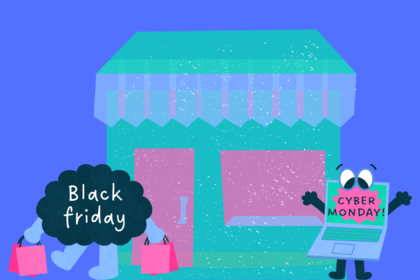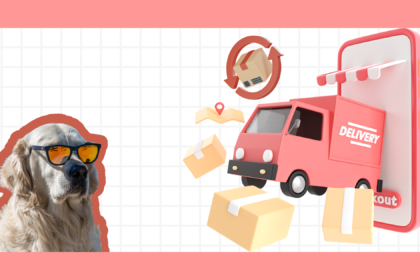Is user-generated content (UGC) really worth your time if you’re a retail business owner?
Without a doubt.
In this article, let’s take a look at the advantages of making use of content created by customers on your eCommerce website and social media accounts, as well as find out how important and powerful they can be in the online retail sphere.
We’ll also take a peek at the latest trends in user-generated content and how some brands are leveraging it.
If you own a retail eCommerce business, you’ve probably looked for ways to provide customers the best shopping experience possible while also saving on expenses. Read till the end for a great way to do that.
What is User-Generated Content?
User-generated content (UGC) includes various types of content voluntarily created by people and shared online (on social media for example).
Such user-created content serves as social proof for businesses and is contributed by people voluntarily without pay.
User-Generated Content is also known as earned media or earned content and takes up the E in the PESO (Paid, Earned, Shared, Owned) model coined by Gini Dietrich’s 2014 book Spin Sucks, consists of content in the form of:
- Customer reviews
- Blogs or articles published by customers/users
- Word of mouth
- Replies or comments to your social media post
That’s not all! User-Generated Content has a horde of benefits which we’ll see further below.
How Can User-Generated Content Benefit Your eCommerce Business?
A significant 70% of consumers will consider user-generated content such as reviews or ratings before making a purchasing decision. At least 41% of them will read four to seven reviews to gain important insights on a product.” – Tint
If that’s not clear enough, here’s something more for you:
- User-generated content is realistic – Today’s customers are so aware that they see right through the difference between a PR campaign and a review from an actual customer. Marketing campaigns are slick – no doubt but it lacks the honesty in a real person’s real opinion. And people want honesty rather than glossy.
- People trust user-generated content more – Not just paying attention to but people tend to trust the opinions of others more than dry advertisements or the results of pure marketing. Moreover, in this age of social media, customers are expected to trust a stranger online and not just their close friends when it comes to choosing a product.
With the help of increased brand awareness and credibility, you can also influence purchasing decisions and inspire prospective customers to hit the ‘buy button’.
This is why placing user-generated content on your customer-facing pages/channels can be a good ploy.
Which Retail Verticals are Best Suited to User-Generated Content?
To be clear, implementing user-generated content in one way or another will help your eCommerce business regardless of industry. Yet, it’s vital to understand that user-generated content won’t work equally well for all spheres.
Some retail verticals that should be using user-generated content for sure are businesses that are dealing in apparel, home decor, beauty products, children and pets products, etc.
And as far as demographics are concerned, with the boom of social media, millennials, more than any other generation, are inclined toward user-generated content.
“Roughly 30% of the time that millennials spend consuming all media is spent on user-generated content. 84 percent of millennials report that user-generated content has some influence on what they buy.” – CrowdRiff
With the basics of user-generated content out of the way, let’s take a look at what the latest eCommerce trends in user-generated content are.
The Latest eCommerce User-Generated Content Trends in 2021
Without a doubt, a big part of the effectiveness of your user-generated content strategy will depend on how well it is executed.
Consistency is among the main points to keep in mind for sure. Similarly, giving something in return to your customers for their content can be a good move (for instance, you could motivate your customers by offering them a discount, coupon, or free product delivery in return for reviewing the product they bought from you).
Here’s how renowned brands are leveraging user-generated content in 2021:
1. Linking Social Media to Your Website
One of the first places to look for user-generated content is your social media channels.
Posts that your customers make on Facebook, Pinterest, Instagram, or even TikTok can be useful. Thus, adding functionality to connect your official social media accounts to your online store is the first step you should take.
Importantly, make sure to give credit to content creators, state what should be done to be featured, and think of a way to organize content in such a way to promote what you’re selling.
Here’s what a user-generated content section on the official Puma website looks like.
Placed right on the home page, the “AS WORN BY YOU” block allows for adding photos to the gallery and also explains how to mention the brand on Instagram. The carousel with the photos shows the name of the contributor.
When a post is clicked, we can see the tagged product on the picture and a button with a CTA that allows us to purchase the item.
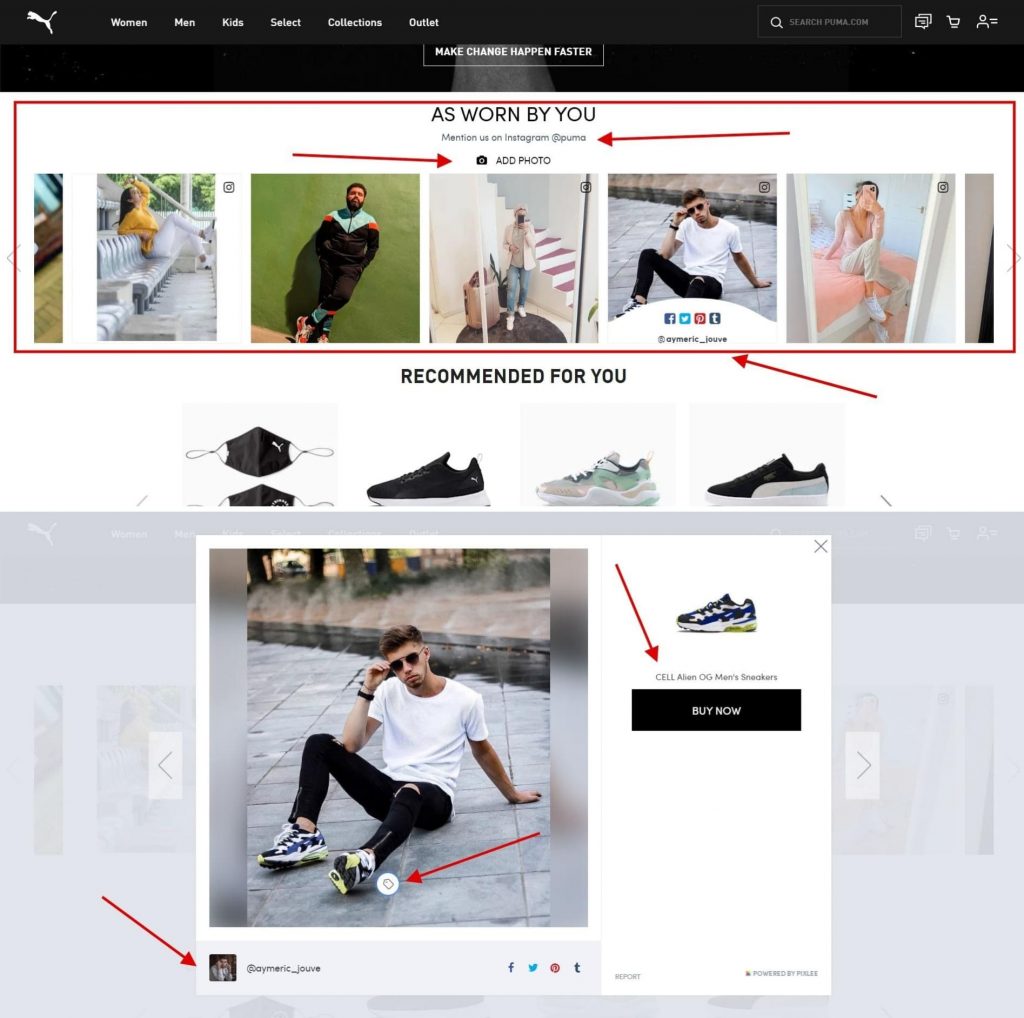
2. Enhancing Product Pages With User-Generate Content
Undoubtedly, placing user-generated content on the product pages of your online store is a blazing tactic too. Not only can you build trust this way but can also showcase how your customers are using a product. The latter can result in the “I want this too” reaction and lead to a sale.
The Prismatic Shadows product page on the official NYX Cosmetics website is a good example.
First of all, the highlighted pink “@NYXCOSMETICS” heading hints at how to tag a social media post in order to be featured. The “NYX Cosmetics Community” section displays photos of the looks that people have created with the product that’s on sale.
These photos are collected on the website by a widget that pulls out those posts that mention the brand and that have corresponding hashtags and products that were used for creating a particular look.
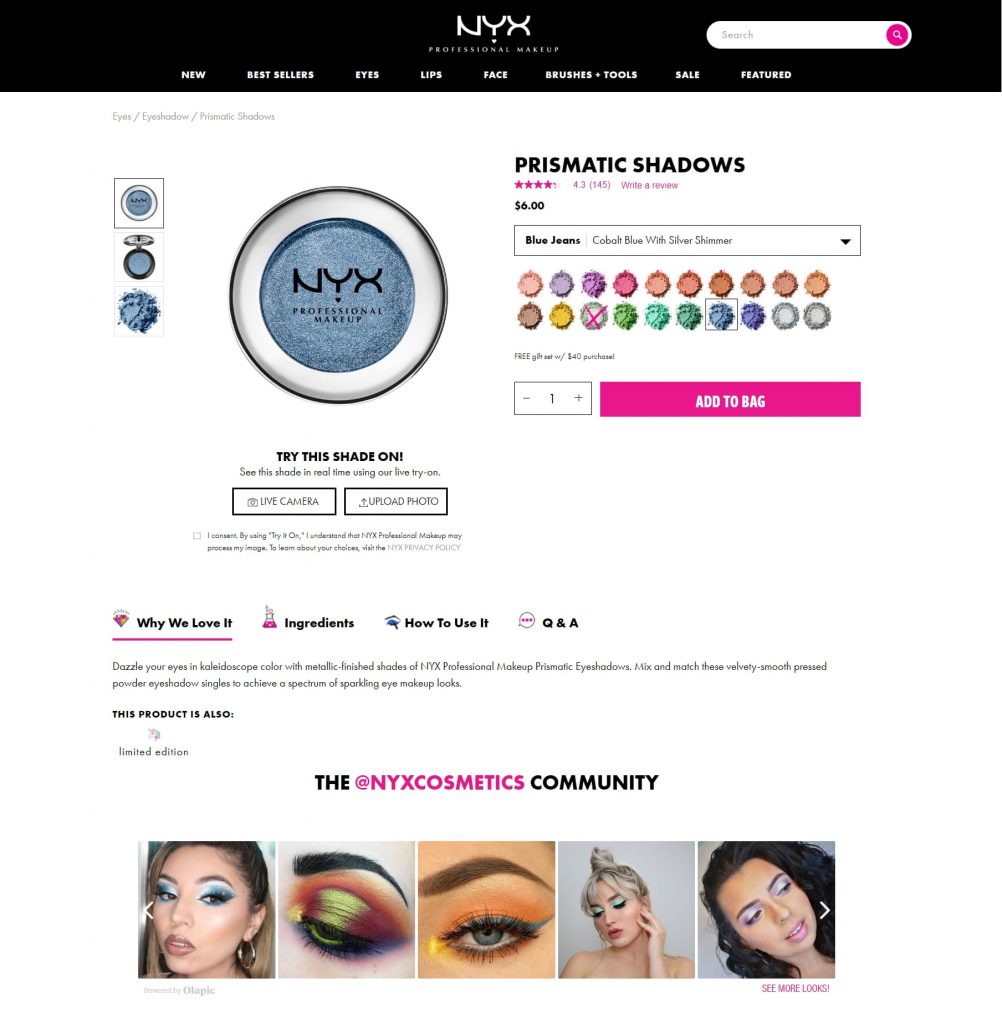
3. Displaying Customer Feedback With Visuals
Positive customer reviews are immensely effective at convincing someone to make a purchase decision.
On your site, customers could share what they like and dislike about the product they’ve bought or their impressions of the service they received.
Apart from just submitting text, giving users the opportunity to back up their feedback with pictures makes a lot of sense.
Here’s a tip: To avoid fraud reviews, make sure to verify every review that’s added. You should be certain that every piece of feedback is from a real customer.
Let’s take a look at how the official Azazie website uses this strategy out of user-generated content.
Since buying wedding dresses online without a physical try-on can be a stressful experience, seeing pictures of other real brides (not just models) wearing the dress can be a relief.
The product page is equipped with a gallery that gathers all customer images featuring a specific product.
Even better, the testimonials include pictures and other important data apart from the comment (the size the customer wears, their body type, the item’s fit, rating, etc).
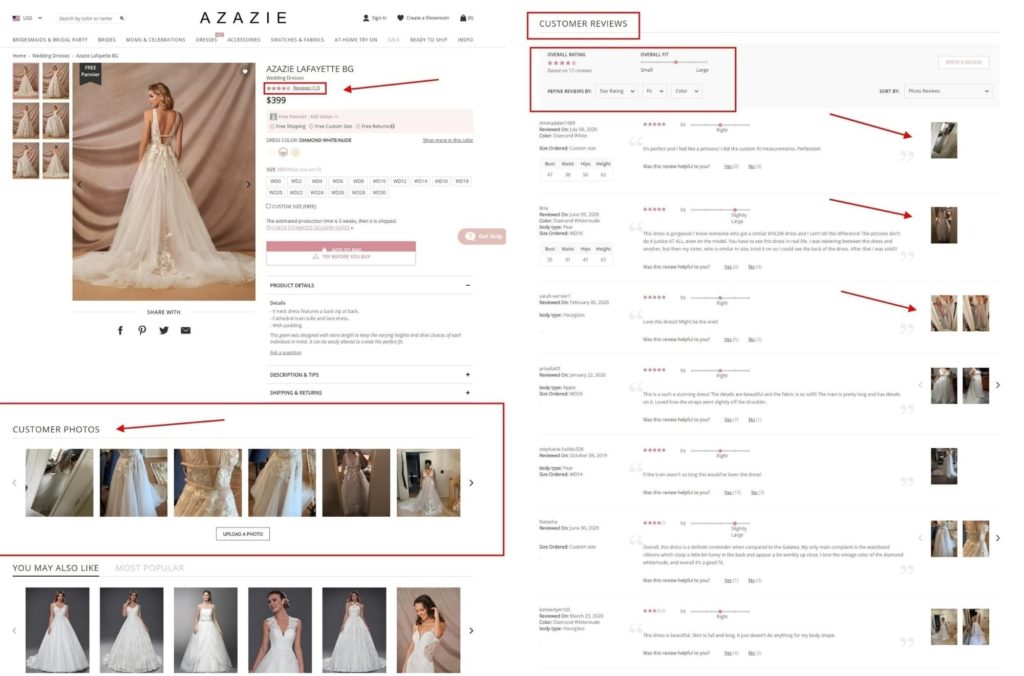
4. Cross-Posting on Various Social Media Channels
Like we mentioned earlier, it’s worth noting that user-generated content works well not only on eCommerce websites but on social media channels too.
Reposting content in which you’re featured and sharing feedback on your business accounts is a great tactic.
This way, you additionally expand the content on your accounts and can increase the number of views. To give an example, this screenshot was taken from the Stories of the official MAC Cosmetics Instagram account.
Having run a short survey, they’ve collected feedback from clients regarding their favorite lipstick and shade. Noteworthy, the “See more” button leads viewers to a page where they can order the item (this is possible only if the business account has an Instagram Shop).
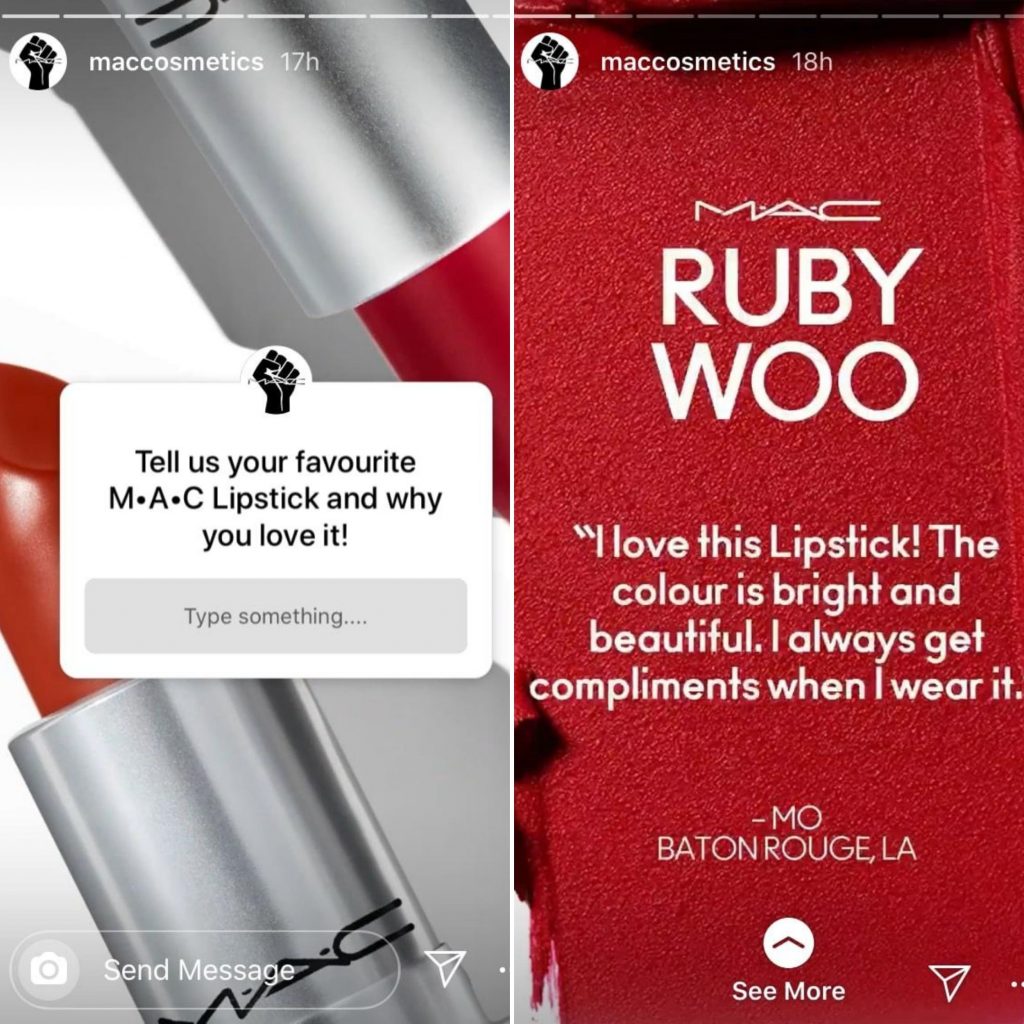
5. Boosting Email Send-outs & Ads
It is a great idea to enhance email campaigns with user-generated content.
Be it a quote from a customer’s testimonial or an image of a happy customer, the click-through rates of a mailer featuring such content will be higher.
Luckily, most email campaign builder tools are already armed with functionality that allows for linking UGC from social media as well as boast various templates that can assist in designing beautiful blocks with customer reviews and content.
Finally, just as in the case with email campaigns, the click-through rates of ads are several times higher if they feature an element of user-generated content. This means that you can potentially cut costs on PPC and save more of your marketing budget.
Final Word
All in all, user-generated content is a mighty marketing resource and weapon that’s especially relevant in retail eCommerce.
Because people tend to believe the opinions of others and are often moved by the trends that others start, user-generated content is a strategy that can not only spark the interest of your customers but also ultimately result in more sales.
About the Author

Alex Husar is CTO at Onilab with 8+ years of experience in Magento and Salesforce development services. He graduated from the Czech Technical University and obtained a bachelor’s degree in Computer Software Engineering. Alex’s expertise includes both full-stack dev skills and a strong ability to provide project-critical guidance to entire teams
A Little about LateShipment.com
LateShipment.com is the world’s only logistics cloud tool that helps businesses of every size reduce shipping costs by up to 20% and provide memorable delivery experiences to customers at scale.
At LateShipment.com, our focus has remained steadfastly on the last mile, typically the part of the logistics chain that is the most opaque.
Some of our high-impact offerings are :
- Save up to 20% on Shipping – Automatically audit your shipping carriers’ invoices and recover refunds for 50+ service failures & billing errors including late deliveries.
- Real-Time Visibility – Monitor your outbound & inbound shipments across multiple shipping carriers on a centralized window, in real-time.
- Critical Delivery Alerts – Pay attention to daily deliveries with predictive delay alerts and more on a purpose-built dashboard for support reps.
- Proactive Issue Resolution – Proactively communicate with customers to prevent them from having bad experiences due to delivery failures.
- Custom Delivery Notifications – Send custom or automated delivery status notifications for events like “shipped,” “attempted,” & “delivered.”
- Branded Tracking Pages – Build fully customizable order tracking pages for your customers to improve brand recall and sales.
The best part is, it takes less than 2 minutes to see LateShipment.com in action.



